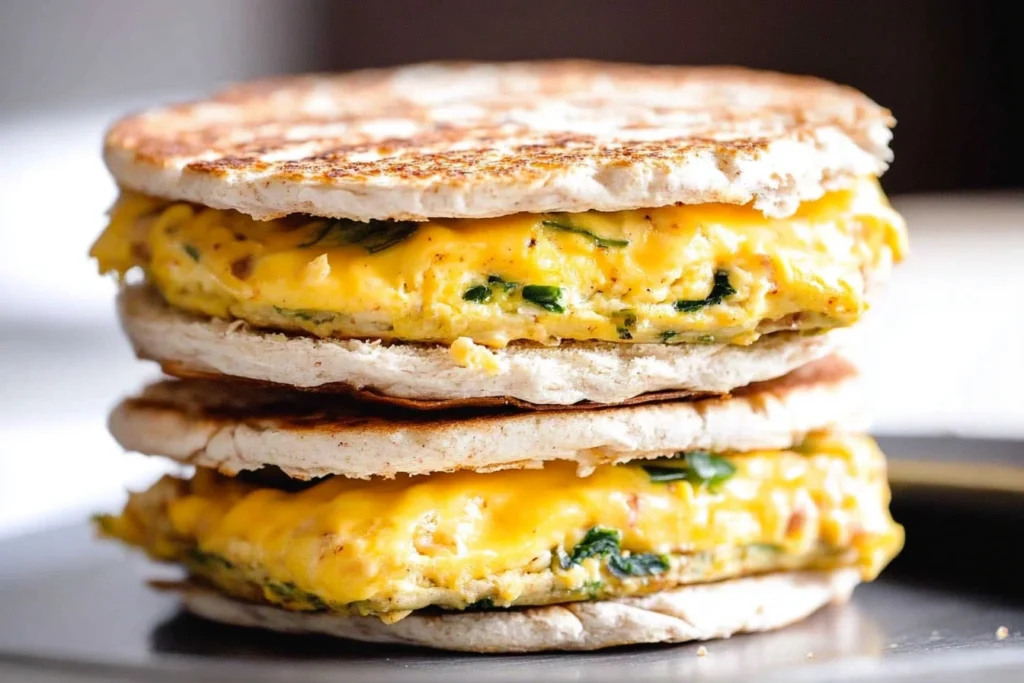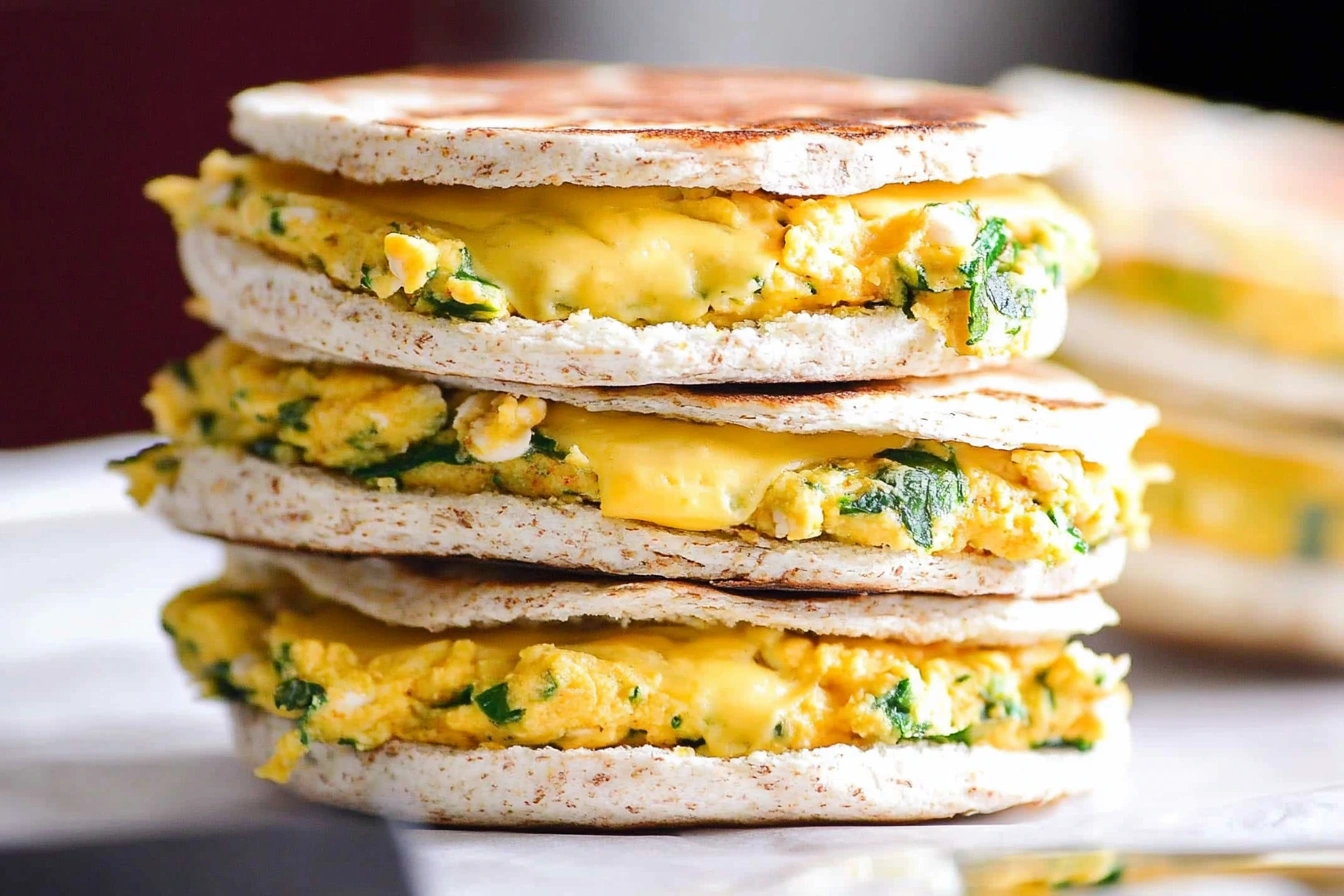Breakfast sandwiches are not just quick and convenient—they’re also an excellent way to kickstart your day with balanced nutrition. Whether you’re rushing out the door or enjoying a leisurely morning, a healthy breakfast sandwich can satisfy your taste buds while fueling your body. This article covers everything you need to know about crafting these sandwiches, from essential ingredients to creative recipes.
Why Healthy Breakfast Sandwiches are the Perfect Start to Your Day
Benefits of Eating a Healthy Breakfast
Starting your day with a balanced breakfast has been shown to boost energy levels, improve concentration, and regulate metabolism. By opting for a nutritious breakfast sandwich, you combine proteins, carbs, and healthy fats into one satisfying meal. For busy mornings, it’s a lifesaver—quick, portable, and delicious.
What Makes a Breakfast Sandwich “Healthy”?
A healthy breakfast sandwich isn’t just about swapping white bread for whole grain. It’s about selecting ingredients that provide long-lasting energy and essential nutrients. Opt for lean proteins like eggs or plant-based alternatives, pile on fiber-rich veggies, and use spreads that are high in healthy fats, like avocado or hummus.
The Appeal of Breakfast Sandwiches in Modern Diets
Why are breakfast sandwiches so popular? They’re versatile, customizable, and perfect for any dietary preference. Whether you’re vegetarian, gluten-free, or on a high-protein diet, you can easily create a sandwich to match your needs. Plus, they fit seamlessly into busy lifestyles without compromising on nutrition.

Ingredients for a Healthy Breakfast Sandwich
Building the Perfect Healthy Breakfast Sandwich
Crafting the ultimate healthy breakfast sandwich starts with thoughtful ingredient choices. A great sandwich balances essential nutrients without overloading on calories.
- Protein Sources: Eggs are a classic go-to, but don’t stop there. Lean turkey slices, grilled chicken, or plant-based options like tofu or tempeh can amp up the protein.
- Carbohydrate Choices: Whole-grain bread, sprouted grain wraps, or even sweet potato slices offer a healthier base packed with fiber and energy-boosting carbs.
- Healthy Fats: Avocado, natural nut butters, or a sprinkle of chia seeds provide heart-healthy fats to keep you feeling full longer.
- Fiber-Rich Veggies: Add spinach, kale, tomatoes, or cucumbers for a vitamin-rich crunch that’s both tasty and nutritious.
Healthy Swaps for Traditional Ingredients
Sometimes, little tweaks can make a big difference:
- Cheese: Opt for low-fat or plant-based cheeses instead of full-fat options.
- Bread: Swap out traditional white bread for whole-grain, gluten-free, or sourdough options.
- Meat: Ditch processed meats like sausage in favor of turkey bacon, chicken breast, or marinated tofu slices.
By mixing and matching these ingredients, you’ll have endless options for a sandwich that feels indulgent but supports your health goals.
Recipes for Healthy Breakfast Sandwiches
Quick and Easy Healthy Breakfast Sandwich Recipes
When it comes to healthy breakfast sandwiches, the possibilities are endless. Here are some delicious ideas you can try, each customizable to suit your taste and dietary needs.
Classic Avocado and Egg Sandwich
- Ingredients: Whole-grain bread, one poached egg, mashed avocado, and a sprinkle of salt and pepper.
- Instructions: Toast the bread, spread the avocado, add the poached egg, and finish with seasoning. Perfect for a creamy and satisfying breakfast.
Vegan Tofu Scramble Breakfast Sandwich
- Ingredients: Firm tofu crumbles, turmeric, nutritional yeast, whole-grain bagel, and sautéed spinach.
- Instructions: Sauté tofu with turmeric and nutritional yeast, layer it on a toasted bagel with spinach, and enjoy a plant-based protein-packed meal.
High-Protein Turkey and Spinach Sandwich
- Ingredients: Whole-wheat English muffin, turkey slices, egg whites, spinach, and a dollop of Greek yogurt.
- Instructions: Cook egg whites and layer them with turkey and spinach on the muffin. Top with a little Greek yogurt for added creaminess.
Mediterranean-Style Breakfast Sandwich with Hummus
- Ingredients: Pita bread, hummus, cherry tomatoes, cucumber slices, and crumbled feta cheese.
- Instructions: Spread hummus inside the pita, add veggies, sprinkle feta, and fold it in half for a fresh, tangy sandwich.
Gluten-Free Breakfast Sandwich Options
- Ingredients: Sweet potato slices (as bread), scrambled eggs, avocado, and turkey bacon.
- Instructions: Roast thick sweet potato slices until soft, then layer with the filling like a traditional sandwich.
Nutritional Benefits of Healthy Breakfast Sandwiches
Why Choose a Healthy Breakfast Sandwich Over Fast Food Options?
Fast food breakfast sandwiches might be convenient, but they often come with hidden downsides like excessive sodium, unhealthy fats, and artificial preservatives. These can leave you feeling sluggish and hungry again soon after. On the other hand, a homemade healthy breakfast sandwich provides a nourishing alternative packed with high-quality ingredients tailored to your preferences. It’s a win-win for your taste buds and your health.
Making your sandwich at home also allows you to avoid empty calories. Fast food options typically use refined bread and fatty meats, which lack essential nutrients. When you choose whole-grain bread, lean proteins, and fresh veggies, you create a satisfying meal that fuels your day effectively.
Macro and Micronutrient Breakdown
A thoughtfully crafted healthy breakfast sandwich delivers a robust combination of macronutrients and micronutrients:
- Protein: Eggs, lean meats, or plant-based proteins support muscle repair and provide steady energy. Including at least 15–20 grams of protein in breakfast is recommended for most people.
- Fiber: Whole grains, avocado, and leafy greens contribute to better digestion, stabilize blood sugar, and help prevent overeating later in the day.
- Healthy Fats: Incorporating sources like avocado, seeds, or olive oil enhances brain function and helps absorb fat-soluble vitamins like A, D, E, and K.
- Vitamins and Minerals: Ingredients such as spinach, tomatoes, and cucumbers are rich in antioxidants and essential nutrients like potassium, vitamin C, and iron, which improve overall health.
Long-Term Health Benefits
Choosing a homemade healthy breakfast sandwich over processed alternatives isn’t just about calories—it’s a lifestyle choice that promotes overall well-being. Some of the long-term benefits include:
- Weight Management: Nutrient-dense breakfasts reduce the likelihood of overeating later in the day. The fiber content from whole grains and veggies keeps you feeling full longer, reducing the temptation for unhealthy snacks.
- Consistent Energy Levels: Unlike fast food breakfasts that cause energy crashes, the balanced macronutrients in a healthy sandwich sustain energy for hours, helping you stay focused and productive.
- Improved Gut Health: Fiber and probiotics from certain ingredients, like fermented sourdough bread or yogurt-based spreads, contribute to a healthy digestive system.
Comparing Calories: Healthy Sandwich vs. Fast Food Alternatives
Let’s put it into perspective:
- A homemade turkey and spinach sandwich with whole-grain bread, avocado, and egg whites clocks in at around 300–350 calories with 20 grams of protein and 7 grams of fiber.
- A comparable fast food sandwich often exceeds 500–600 calories, with as little as 2 grams of fiber and high saturated fats from processed meats and cheeses.
The choice is clear: homemade healthy sandwiches are not just a calorie-conscious option—they’re a way to nourish your body with ingredients that support long-term health.

Tips for Preparing Healthy Breakfast Sandwiches
Time-Saving Tips for Making Breakfast Sandwiches
Mornings can be a whirlwind, and the last thing anyone wants is to spend ages in the kitchen before heading out. But with a few clever hacks, preparing a healthy breakfast sandwich can be quick and stress-free:
- Meal Prep Ingredients in Advance: Dedicate a little time on the weekend to cook your proteins, such as eggs, chicken sausage, or tofu scramble. Store them in individual portions in airtight containers so they’re ready to grab and assemble. Pre-washing and chopping veggies like spinach, bell peppers, and tomatoes can shave valuable minutes off your morning routine.
- Batch Cooking: Double or triple your sandwich recipes and assemble several at once. Wrap each sandwich tightly in foil or parchment paper, then store them in the freezer. On busy mornings, just pop one into the microwave or toaster oven for a fresh, hot breakfast in no time.
- Keep It Simple: Sometimes, less is more. Use ready-to-eat items like pre-sliced cheese, pre-cooked turkey bacon, or baby spinach. This approach ensures you’re not skipping breakfast due to time constraints.
Another tip? Set up an assembly line. Lay out all your ingredients—bread, spreads, proteins, and veggies—and build your sandwiches systematically. You’ll be amazed at how quickly you can churn out several sandwiches with this method!
Tools and Gadgets to Streamline Preparation
Having the right tools in your kitchen can make preparing healthy breakfast sandwiches quicker and more enjoyable. Here’s a list of handy gadgets that can save you time and effort:
- Non-Stick Pan or Griddle: Perfect for cooking eggs, turkey patties, or even lightly toasting your bread without needing excessive oil. Cleanup is also a breeze!
- Egg Molds: These circular molds help you create eggs that fit perfectly on muffins or bagels. You can even experiment with different shapes for a bit of fun.
- Panini Press or Sandwich Maker: Toast your sandwich to perfection with melty cheese and a satisfying crunch. Some models even seal the edges, making your sandwich easier to handle on the go.
- Storage Solutions: Invest in BPA-free airtight containers or reusable silicone bags. These are great for storing prepped ingredients or freezing sandwiches without risking freezer burn.
Using these tools, you’ll feel like a breakfast sandwich pro in no time. Plus, they’ll save you from morning chaos, leaving more time to enjoy your meal.
Storage and Reheating Tips
A well-prepped healthy breakfast sandwich can be just as delicious and fresh the next day or even a week later if stored properly. Here’s how to keep them fresh:
- Freezing: If you’re prepping for the week, freezing is the way to go. Wrap each sandwich tightly in foil or parchment paper, then place them in resealable freezer bags to keep them fresh and prevent freezer burn. They’ll stay good for up to two weeks. Label each bag with the date to keep track of their freshness.
- Refrigeration: If you plan to eat your sandwich within 24–48 hours, refrigeration works well. Use airtight containers or reusable silicone wraps to keep them fresh and prevent sogginess. Avoid adding watery ingredients like fresh tomatoes until just before eating to preserve texture.
- Reheating: For frozen sandwiches, reheat in the microwave on medium power for about 1–2 minutes. To maintain crispness, follow up with a quick toast in a pan or toaster oven. Refrigerated sandwiches need less heating time—30–60 seconds in the microwave usually does the trick.
For best results, avoid reheating sandwiches wrapped in foil in the microwave—transfer them to a microwave-safe plate first. With proper storage and reheating, your breakfast sandwich will taste just as good as when it was first made.
Additional Tip: Keep It Fresh
If you’re someone who loves a variety of flavors, consider prepping your sandwiches with mix-and-match ingredients. For example, use spinach and eggs in one batch and avocado and turkey in another. This way, your breakfasts will never feel repetitive.
By following these tips, you can simplify your morning routine and ensure you always have a delicious, homemade breakfast ready to go
Exploring Variations and Customizations
Creative Ideas for Healthy Breakfast Sandwiches
One of the best things about a healthy breakfast sandwich is its versatility. With a few tweaks, you can cater to different dietary preferences, regional flavors, or seasonal ingredients. Here are some inspiring ideas to spark your creativity in the kitchen.
Regional-Inspired Healthy Breakfast Sandwiches
- Mexican-Style Breakfast Sandwich: Use a whole-grain tortilla or bread, scrambled eggs with black beans, diced tomatoes, avocado, and a sprinkle of low-fat cheese. Add a dash of salsa or a hint of cilantro for a zesty kick.
- Mediterranean-Inspired Sandwich: Opt for pita bread stuffed with hummus, fresh cucumber slices, cherry tomatoes, crumbled feta cheese, and grilled chicken or falafel for a protein boost.
- Asian-Inspired Sandwich: Try rice cakes as the base, topped with scrambled eggs, spinach, sesame seeds, and a drizzle of soy sauce or teriyaki glaze.
Seasonal Ingredient Ideas
- Spring Sandwich: Include fresh arugula, asparagus tips, and soft goat cheese on a toasted whole-grain bagel.
- Summer Sandwich: Use sliced heirloom tomatoes, basil leaves, and mozzarella on a whole-wheat English muffin for a Caprese-inspired sandwich.
- Autumn Sandwich: Add roasted sweet potato, kale, and turkey slices to a toasted sourdough bread.
- Winter Sandwich: Layer sautéed mushrooms, spinach, and scrambled eggs on multigrain toast with a dollop of pesto for added flavor.
Sandwiches for Dietary Preferences
Whether you’re following a specific diet or have food sensitivities, a healthy breakfast sandwich can be easily adapted:
- Keto-Friendly Options: Replace bread with lettuce wraps, portobello mushroom caps, or chaffle buns (made from eggs and cheese). Fill with avocado, bacon alternatives, and spinach for a low-carb delight.
- Dairy-Free Choices: Swap regular cheese for plant-based alternatives like cashew cheese or nutritional yeast. Spread tahini or hummus on your sandwich for creamy goodness without dairy.
- Low-Calorie Alternatives: Use thin slices of whole-grain bread or skip the bread altogether and opt for veggie bases like roasted eggplant or bell pepper halves. Fill with lean proteins and fresh greens to keep the calorie count light.
Combining Flavors for Unique Creations
- Experiment with spreads like tzatziki, mustard, or a light garlic aioli for added flavor.
- Add fresh herbs like basil, cilantro, or parsley to enhance the aroma and taste.
- Sprinkle in extras like pumpkin seeds, flaxseeds, or microgreens to boost texture and nutrition.
A healthy breakfast sandwich is more than just a meal; it’s a canvas for your culinary imagination. By playing with ingredients, textures, and flavors, you can enjoy a different sandwich every day while staying true to your health goals.

Frequently Asked Questions
Can a breakfast sandwich be healthy?
Absolutely! A breakfast sandwich can be healthy when made with nutrient-dense ingredients like whole-grain bread, lean proteins, fresh vegetables, and healthy fats. By avoiding processed meats and high-calorie spreads, you can create a meal that’s both delicious and nourishing.
What is the healthiest meat for breakfast sandwiches?
The healthiest meat options for breakfast sandwiches include lean proteins like turkey breast, grilled chicken, or smoked salmon. These meats are lower in saturated fat and calories compared to options like sausage or bacon, while still providing a good amount of protein to keep you full.
What’s the healthiest filling breakfast?
A healthy and filling breakfast typically includes a balance of protein, healthy fats, and fiber. A breakfast sandwich made with whole-grain bread, eggs or tofu, avocado, and a handful of fresh veggies checks all these boxes, keeping you energized and satisfied throughout the morning.
What is the healthiest bread for breakfast sandwiches?
Whole-grain bread is the healthiest choice for breakfast sandwiches as it’s rich in fiber, vitamins, and minerals. Other great options include sprouted grain bread, sourdough, and gluten-free alternatives, depending on your dietary needs. These types of bread provide sustained energy and better digestion compared to refined white bread.
Conclusion
A healthy breakfast sandwich is a simple yet versatile way to start your day on the right foot. By carefully selecting nutrient-rich ingredients like whole grains, lean proteins, healthy fats, and fresh vegetables, you can create a balanced meal that’s both satisfying and nourishing. These sandwiches aren’t just quick and portable—they’re a customizable canvas for your unique tastes and dietary preferences.
From meal prep tips to creative variations, this guide shows that healthy eating doesn’t have to be complicated or time-consuming. Whether you’re rushing out the door or enjoying a relaxed morning, a homemade breakfast sandwich can provide the fuel you need to tackle the day ahead.
So why not give it a try? Experiment with flavors, keep it simple, and enjoy the benefits of a wholesome breakfast sandwich that keeps you energized and feeling great. Happy sandwich-making!

